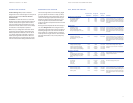15
KEEPING FOOD AT ITS BEST
KEEPING FOOD FRESH
Your Sub-Zero unit features our unique dual
c
ompressor refrigeration systemtokeep food
fresher longer. However,the quality and safety of
your food also depends onhow you handle it.
The information in this section gives you the
most up-to-date handling and storage recom-
m
endations to help you keep food at its best. If
you have specific questions that are not
a
ddressed here, contact aUniversity or County
Extension Service or your local utility company.
Most food inevitably deteriorates over time.
From the verybeginning until it is consumed,
food undergoes changes. Microorganisms get
into food, multiply andcause spoiling.
Enzymes that occur naturally infood continue
the ripening process even after the food is har-
vested. Improper temperatures cause foodto
deteriorate faster. Changes in humidity cause
wilting andshriveling that can lead to spoiling.
Sub-Zero’s dual refrigeration system isspecifi-
cally designed to combat these changesand
keep your food fresh longer. The individual
refrigerator and freezer systems havebeen
designed to maintain accurate, consistent tem-
peratures andproper humidity levels for longer
food life expectancy. Dual refrigeration elimi-
nates transfer of fresh food odors to frozen food
or ice anddoes not freeze the moisture outof
the air inthe fresh foodsection.
In addition, good handling practices can mini-
mize the rateof changes infood.
HANDLING RECOMMENDATIONS
•
Follow the recommendedstorage times and
temperatures in this guide. Your Sub-Zero
u
nit helps to slow the ripening process by tai-
loring temperaturestoeach section as
needed.
•
Use specially designed compartments for
dairy foods, deli foods and fresh produce.
These compartments maintain temperature
and humidity levels that keep specific food
groups fresh.
• Rotate food in refrigeration units, usinga
first-in, first-out system.
• When food does spoil, it’susually obvious. It
becomes moldy, has anoff-odor and looks
rotten. But there are times when spoilingmay
not be so apparent. If you think a food has
been stored too long, discardit. Don’t taste it
to check if it’sokay.
KEEPING FOOD SAFE TO EAT
Most food-borne illness is caused by bacteria
s
uch a Staphylococcus, Salmonella, E-coli and
Clostridium botulinum, the bacteria that causes
botulism. These bacteria grow rapidly at temper-
atures between 4˚C and60˚C, a range that’s
called the
Danger Zone
. Never leave food in the
danger zone for more than twohours. When the
bacteria havemultiplied to themillions inwarm
temperatures, they cause illness. Some bacteria
cause flu-like symptoms, while others cause
serious illness or even death. Young children, the
elderly and people who are already ill are more
likely to become sick from food poisoning.
To reduce your risk of food-borne illness, use the
following techniques to keep your food safe to
eat:
WHEN YOU’RE SHOPPING
• Place packages of raw meat, seafood or
poultry inplastic bags to keep them from
dripping on other foods.
• Shop for meat, seafoodand poultrylast.
Don’t leave these foods in a hot car when
you’ve finished shopping. Take along a cooler
in hot weather or when you have to travel
long distances.
• Check
use by
and
sell by
dates on foods to
make sure they’re fresh. Use extra care when
buying delifood. Buy onlythe amount you
will use in 1–2days. Discard hot or cold deli
food that hasbeen at room temperature for
more than twohours.
WHEN YOU STORE FOOD
•
Monitor temperatures of the refrigeratorand
freezer sections onthe electronic control
p
anel of your Sub-Zero unit. Keepthe refrig-
erator temperature at 4˚C or below and
freezer temperatureat-18˚C.
•
Follow the recommendedrefrigerator and
freezer storage times and temperatures in
this guide.
• Store raw meat, poultry and seafood separate
from otherfoods. Keepjuices from these
packages from dripping on other food.
• Never taste food that looks or smells strange
to test its freshness. Discard it.
• For refrigerator storage, leave raw meat,
poultry and seafood in its original wrapper
unless it is torn. Repeated handling can intro-
duce bacteria to these foods.
• Wrap food storedin the refrigerator unit in
foil or plastic wrap, or place it in plastic bags
or airtight containers to keep it fromdrying
out. Date allpackages.
• For freezer storage, use freezer wrap, freezer-
quality plastic bags or aluminum foil over the
commercial wrap if foods will be stored in the
freezer for more than a couple of months.
This minimizes dehydration and qualityloss.
Single layers of aluminum foil may tear and
cause freezer burn.


















